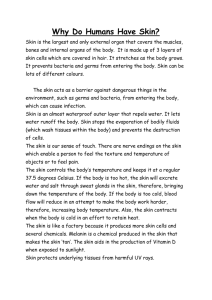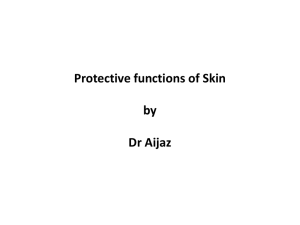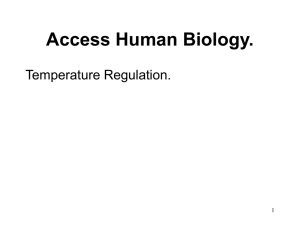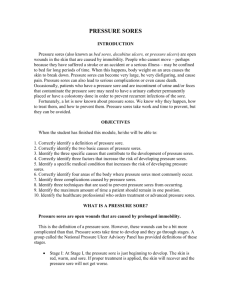Skin care PDF - AmeriBest home care
advertisement
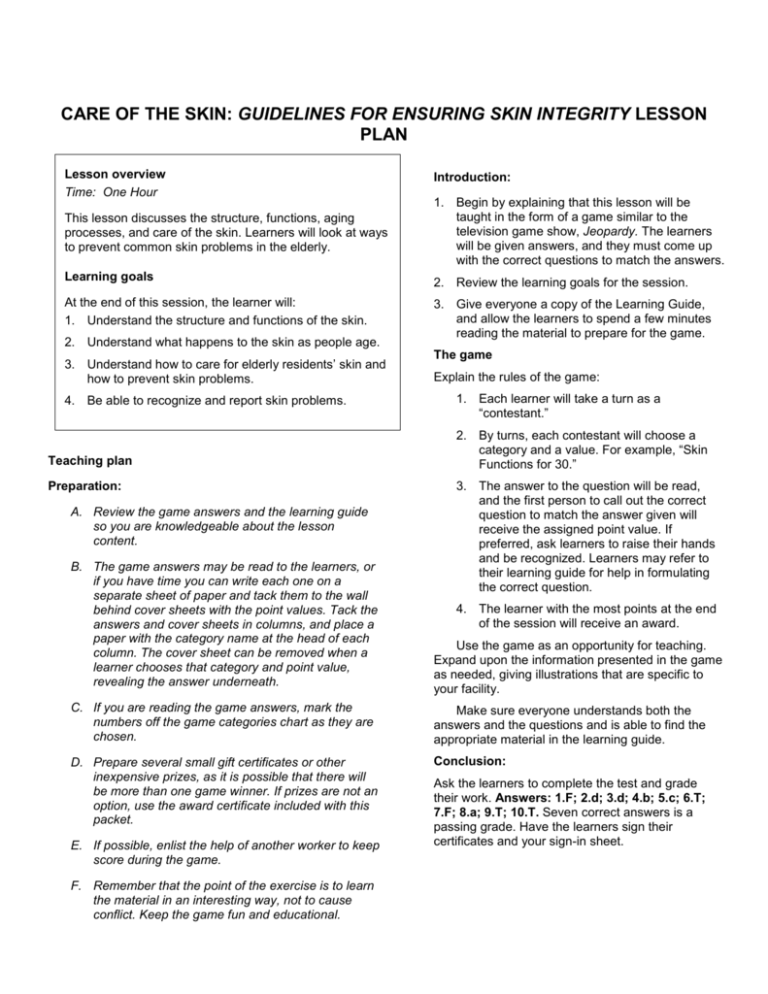
CARE OF THE SKIN: GUIDELINES FOR ENSURING SKIN INTEGRITY LESSON PLAN Lesson overview Time: One Hour Introduction: This lesson discusses the structure, functions, aging processes, and care of the skin. Learners will look at ways to prevent common skin problems in the elderly. 1. Begin by explaining that this lesson will be taught in the form of a game similar to the television game show, Jeopardy. The learners will be given answers, and they must come up with the correct questions to match the answers. Learning goals 2. Review the learning goals for the session. At the end of this session, the learner will: 1. Understand the structure and functions of the skin. 3. Give everyone a copy of the Learning Guide, and allow the learners to spend a few minutes reading the material to prepare for the game. 2. Understand what happens to the skin as people age. 3. Understand how to care for elderly residents’ skin and how to prevent skin problems. 4. Be able to recognize and report skin problems. Teaching plan Preparation: A. Review the game answers and the learning guide so you are knowledgeable about the lesson content. B. The game answers may be read to the learners, or if you have time you can write each one on a separate sheet of paper and tack them to the wall behind cover sheets with the point values. Tack the answers and cover sheets in columns, and place a paper with the category name at the head of each column. The cover sheet can be removed when a learner chooses that category and point value, revealing the answer underneath. The game Explain the rules of the game: 1. Each learner will take a turn as a “contestant.” 2. By turns, each contestant will choose a category and a value. For example, “Skin Functions for 30.” 3. The answer to the question will be read, and the first person to call out the correct question to match the answer given will receive the assigned point value. If preferred, ask learners to raise their hands and be recognized. Learners may refer to their learning guide for help in formulating the correct question. 4. The learner with the most points at the end of the session will receive an award. Use the game as an opportunity for teaching. Expand upon the information presented in the game as needed, giving illustrations that are specific to your facility. C. If you are reading the game answers, mark the numbers off the game categories chart as they are chosen. Make sure everyone understands both the answers and the questions and is able to find the appropriate material in the learning guide. D. Prepare several small gift certificates or other inexpensive prizes, as it is possible that there will be more than one game winner. If prizes are not an option, use the award certificate included with this packet. Conclusion: E. If possible, enlist the help of another worker to keep score during the game. F. Remember that the point of the exercise is to learn the material in an interesting way, not to cause conflict. Keep the game fun and educational. Ask the learners to complete the test and grade their work. Answers: 1.F; 2.d; 3.d; 4.b; 5.c; 6.T; 7.F; 8.a; 9.T; 10.T. Seven correct answers is a passing grade. Have the learners sign their certificates and your sign-in sheet. CARE OF THE SKIN: GUIDELINES FOR ENSURING SKIN INTEGRITY LEARNING GUIDE The structure of skin: What skin is Epidermis: The thin, top layer of skin surface Dermis: The thicker layer underneath the surface The dermis contains: Blood vessels: Tubes that carry blood through the body, with oxygen and food Nerves: Fibers that carry sensations to and from the brain Oil glands: Organs that secrete an oily lubricating fluid Sweat glands: Organs that separate waste products from the blood and secrete them as sweat Hair follicles: Organs that create hair Fatty tissue: Layer of fat under the skin. Although it’s not part of the skin, the fatty tissue provides a protective layer of padding (to prevent injury to underlying bones and muscles) and insulation (to keep heat in). Functions of skin: What skin does 1. Controls body temperature a. Releases heat through sweat b. Constricts and expands surface blood vessels to insulate or cool the body 2. Protects against injury and disease a. Covers and pads muscles and bones, preventing damage b. Forms a barrier against harmful organisms and infection 3. Provides sensations a. Nerve endings sense danger b. Sensitive to pressure, pleasure, pain, and temperature 4. Creates Vitamin D a. Produced by sunlight on the skin 5. Cares for itself a. Self-lubricates with oil glands 6. Warns of disease a. Changes in color, temperature, or moistness may signal illness The aging of skin: What happens The skin and fatty tissue layer get thinner. The skin becomes less elastic. Oil glands produce less oil, so skin is dry. Blood vessel walls get thinner and more delicate, so they break easily. Circulation of the blood slows down, so the skin is not getting as much oxygen and nutrition from the blood, causing the skin to become poorly nourished and fragile. Because of these changes in the skin, older people: Tend to feel cold Suffer from skin tears Heal slowly Become wrinkled Develop pressure sores Caring for older skin: What to do Keep skin clean. o Pat skin, don’t rub, when washing or drying. o Use powder sparingly—excess powder can cause irritation. Keep skin lubricated. o Use lotions liberally. o Frequent bathing with soap will dry the skin—use lotion cleansers. Keep skin creases and folds dry. Keep clothes and bedding dry. Eat nutritious food and drink lots of water. Change position often to improve circulation and prevent pressure sores. Don’t disturb moles. Massage the skin, but avoid bony projections and irritated areas: Massage around but not directly on them. Use chair cushions and good beds. Inspect skin daily for redness, tears, blisters, scrapes, or irritated areas. Report problems to a nurse or doctor. Skin problems Decubitus ulcers (Bed sores or pressure sores) Causes: Sustained pressure on the skin compresses the blood vessels and prevents nutrition and oxygen from getting to the skin cells. Over time, the skin tissue dies and decubitus ulcers develop. The skin is under pressure where the bones press against the skin tissue, especially when the weight of the body or a body part is pushing down on a pressure point. Body fluids such as urine and feces contain damaging chemicals. When they remain on the skin, they cause moist areas that become irritated and develop sores. Friction from clothing or bedding can injure the skin and lead to skin ulcers. What to report to the nurse, doctor, or supervisor: o A red pressure area that does not become normal after 20 minutes without pressure o A reddened area of the skin that does not turn white when you push on it o A skin area that is warm or hot to the touch o Any swelling o Any opening in the skin o Blisters, tears, craters, rashes, or holes o Scrapes or abrasions o Drainage or weeping from the skin Be especially alert when you are caring for residents that are frail, don’t move around much, or have poor nutrition. Patients with little or no feeling in parts of the body, such as stroke victims, must be watched because they don’t feel pressure spots and change position when they should. Preventing skin problems Encourage or help patients to walk or exercise several times a day. Encourage or help patients to keep their skin clean, dry, and lubricated. Encourage or help patients to keep their bedding free of wrinkles. Encourage or help patients to eat well and drink plenty of liquid. For patients who are in chairs most of the time: Encourage or help them to stand, walk, or shift their weight every 15 minutes. Teach them how to do chair push-ups with their arms. Teach them to sit with their knees at the same level as their hips, with their thighs horizontal to the chair. This will distribute their weight along their thighs and away from pressure points. If a patient cannot do these things, he or she should return to bed after an hour in a chair. For patients who are in bed most of the time: Teach them how to use side rails and the trapeze to change position frequently, at least every two hours. Be available to assist them if necessary. Even small shifts in body weight are helpful. When you are helping a patient to change position, move him or her carefully so you do not create friction and shearing between the skin and the bedding or clothes. The head of the bed should be raised as little as possible, no more than 30 degrees, to prevent sliding and pressure on the bony areas. If it must be raised higher for eating, it should be lowered an hour later. Massage the skin when possible, but avoid massaging pressure points or irritated areas. For patients who use special chair cushions or mattress overlay pads: Check to be sure that the pads are thick enough to do the job. Place your hand under the pad while the resident is on top of it—if you can feel the patient’s body through the cushion, the pad is too thin. For patients with pressure sores: Keep weight and pressure off any reddened areas and wounds. Use pillows to elevate or separate body parts and keep pressure off an area, such as a pillow under the calf to raise the heel off the bed, or a pillow between the legs to keep the knees from touching each other. CARE OF THE SKIN: TEST Name: ________________________________________ Date: ________________ Score: ____________ (number correct) Circle the right answer. 1. A little blister on an elderly person’s skin is normal and nothing to be concerned about. True or False 2. You should report a reddened area on the skin to the nurse or your supervisor if: a. It has a dark black or brown center. b. It doesn’t turn white under your thumb when you press on it. c. You remove all pressure from it and it still doesn’t return to a normal skin color after 20 minutes. d. b and c 3. You should encourage residents to have healthy skin by: a. Bathing frequently with soap and water. b. Only bathing occasionally. c. Using lots of powder in all the skin folds and creases. d. Staying clean, using lotion, eating well, drinking water, and exercising. 4. When sitting in a chair for long periods, your patients should: a. Sit with knees higher than hips. b. Get up or shift their weight every 15 minutes. c. Stay there as long as possible. d. Avoid shifting their weight in the chair too much. 5. Older people are at risk for pressure sores because: a. They eat too much. b. They bathe too often. c. The skin, the fatty tissue layer, and the blood vessel walls are thinner and more fragile. d. Their bones get sharper as they age. 6. Changes in a person’s skin color could be a sign of illness. True or False 7. People who are in bed most of the time should keep the head of their bed raised as high as possible, because a sitting position is better for circulation than a lying position. True or False 8. Older people tend to feel cold because: a. The fatty tissue layer is thinner and the blood vessels don’t expand and contract as well. b. They don’t wear enough clothes. c. Their internal thermostat doesn’t work anymore. d. None of the above. 9. Older people heal slowly because the skin is not getting enough oxygen and nutrition. 10. People who have had strokes or are paralyzed must be watched closely for skin ulcers. True or True or False False Skin structure Skin functions Aging skin Skin care Skin problems 10 points 10 points 10 points 10 points 10 points 20 points 20 points 20 points 20 points 20 points 30 points 30 points 30 points 30 points 30 points 40 points 40 points 40 points 40 points 40 points 50 points 50 points 50 points 50 points 50 points 60 points 60 points 60 points 60 points 60 points 70 points 70 points 70 points 70 points 70 points 80 points 80 points 80 points 80 points 80 points 90 points 90 points 90 points 90 points 90 points 100 points 100 points 100 points 100 points 100 points Skin structure 10 points The top layer of the skin 20 points Nerves 30 points Organs that create hair Skin functions 10 points Vitamin D 20 points By lubricating the skin 30 points The skin covers and pads them Aging skin 10 points Get thinner with age 20 points It becomes wrinkled 30 points It is caused by the oil glands producing less oil Skin care 10 points Don’t disturb these 20 points Pat, don’t rub 30 points Inspect the skin this often 40 points The dermis 40 points By releasing heat through sweat 50 points Danger 60 points Forms a barrier against harmful organisms and infection 70 points Pressure, pleasure, pain, and temperature 80 points Changes that may warn of disease 90 points They constrict and expand to warm or cool the body 100 points Six things the skin does 40 points Becomes slower with age 50 points Becomes less stretchy 60 points Because the skin loses its ability to control temperature 70 points Because they get thinner and more delicate 80 points Because the skin is dry, thin, and fragile 90 points These are carried by the blood in the blood vessels 100 points Five results of aging skin changes 40 points Frequent bathing with soap 50 points Nutritious food & water 60 points To improve circulation and prevent pressure sores 70 points Things that should be kept dry 80 points Do this, but not directly on irritated areas 90 points Use one sparingly and the other liberally 50 points Oil glands 60 points Layer of fat under the skin 70 points Blood vessels 80 points Sweat glands 90 points Padding to prevent injury and insulation to stay warm 100 points Structures that are contained in the dermis 100 points Five things that should be reported to a nurse CARE OF THE SKIN: THE GAME CARE OF THE SKIN: GAME QUESTIONS (ANSWER SHEET) Skin problems 10 points Swelling 20 points Every two hours 30 points Body fluids that contain chemicals harmful to the skin 40 points Pressure points 50 points Keep it wrinkle-free 60 points Sustained pressure on blood vessels prevents cell nourishment 70 points Move people carefully in bed to avoid this 80 points Pillows 90 points Residents with little or no feeling in parts of the body 100 points One hour Skin structure 10 points What is the epidermis? 20 points What are fibers that carry sensations to and from the brain? 30 points What are hair follicles? 40 points What is the thicker layer of skin under the surface? 50 points What are organs that secrete an oily lubricating fluid? 60 points What is the fatty tissue? 70 points What are tubes that carry blood through the body with oxygen and food? 80 points What are organs that separate waste products from the blood and secrete them as sweat? 90 points What does the fatty tissue layer provide? 100 points What are blood vessels, nerves, oil glands, sweat glands, and hair follicles? Skin functions 10 points What is produced by sunlight on the skin? 20 points How do the oil glands take care of the skin? Aging skin 10 points What happens to the skin and fatty tissue? 20 points What is one thing that happens to aging skin? Skin care 10 points What are moles? 30 points How does the skin prevent damage to muscles and bones? 40 points How does the skin control temperature? 50 points What do the nerve endings sense? 60 points How does the skin protect against disease? 70 points What are the nerve endings sensitive to? 80 points What are changes in color, temperature, or moistness? 30 points Why does aging skin get dry? 30 points What should be done every day? 40 points What happens to the circulation as we age? 50 points What happens to the skin as we age? 60 points Why do older people feel cold? 70 points Why do blood vessels break easily? 80 points Why does older skin tear and get sores easily? 40 points What dries the skin? 90 points How do the blood vessels control body temperature? 100 points What are temperature control, protection against injury and disease, provides sensations, creates Vitamin D, cares for itself, and warns of disease? 90 points What are oxygen and nutrients? 100 points What are a tendency to feel cold, suffer from skin tears, heal slowly, become wrinkled, and develop pressure sores? 20 points How should we wash and dry the skin? 50 points What should we eat to have healthy skin? 60 points Why should older people change position often? 70 points What are clothes and bedding? 80 points What is massage? 90 points What are powder and lotion? 100 points What are redness, tears, blisters, scrapes, or irritated areas? Skin problems 10 points What should be reported to a nurse or supervisor? 20 points How often should a bedbound resident change position? 30 points What are urine and feces? 40 points What are places where the bones press against the skin? 50 points How should bedding be maintained? 60 points What causes decubitus ulcers? 70 points What is friction? 80 points What should you use to elevate body parts and keep pressure off an area? 90 points Who should be carefully observed for skin problems? 100 points How long should a resident stay in a chair if he or she can’t stand, walk, or shift weight frequently? Facility: _____________________________ Achievement Certificate Name: ______________________________________ H a s c om p l e t e d t h e on e - h ou r c ou r se “ Ca r e of t h e S k i n : En su r i n g S k i n I n t e g r i t y ” Required for course completion: Scoring seven correct answers on a ten-question test. S i gn atu re o f Pr es en t er (or w r i te “s e lf -s tu d y” ) D at e

